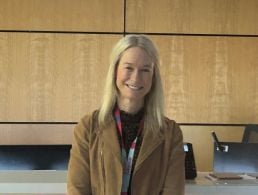Sara Rahmani, VP of people experience and DE&I at Chronus, recommends carefully planned mentoring sessions to get people of all age groups collaborating.
When we think about diversity, equity and inclusion (DE&I) in the workplace, gender, race and accessibility typically crop up. What is often overlooked in these conversations is age.
“Age is an incredibly important aspect of diversity that often gets forgotten,” said Sara Rahmani.
“Age diversity should have an equal seat at the table with other DE&I initiatives, as age diversity adds different perspectives to any room.”
Rahmani is VP of people experience and DE&I at Seattle-headquartered Chronus, a company that develops workplace mentoring software.
“Encouraging contact and teamwork with members of all age groups can enable a better sharing of perspectives on race, gender and other DE&I issues that interact with workplace culture,” she told SiliconRepublic.com.
With this in mind, age should be considered alongside other factors when we think of diversity, not instead of them. And Rahmani thinks that interaction across ages can help break down stereotypes by giving employees from different generations the chance to get to know each other as real people.
“It fosters cross-organisational networks and continuous learning. It can provide a pathway for younger, newer employees to explain potential weaknesses of the existing company culture to their older counterparts. It can also allow older workers to share institutional knowledge and experiences with their millennials and Gen Z counterparts.”
Company culture
Just like any DE&I policy can help foster a more welcoming workplace and make it more suitable for different types of people, age diversity initiatives can also help improve a company’s culture.
“Younger workers have a pulse on the present and future, while older generations have institutional knowledge of what has come before in their company and industry,” said Rahmani. Mixing older and younger workers and allowing them to learn from each other encourages “a free flow of ideas and experiences”.
“Many in the younger generations are eager to offer their expertise, and this can help improve outdated business practices and streamline technological processes,” she added. “Similarly, older workers have seen and done a lot in their time, and these experiences should be valued.”
‘Encouraging contact and teamwork with members of all age groups can enable a better sharing of perspectives on race, gender and other DE&I issues that interact with workplace culture’
– SARA RAHMANI
Rahmani has seen the value of different age groups working together first-hand throughout her career. Before she started working at Chronus, she created curricula and developed district-wide academic programmes for the Texas public school system.
She has a psychology degree, an MA in education and is currently working on a doctorate in education.
So, for companies that are thinking of improving age diversity in the workplace, how can they go about it?
First of all, Rahmani said it’s important to be mindful of the kind of language we use. Instead of saying “young talent”, for example, employers can say something that’s more neutral and inclusive.
It’s also important to accommodate people’s working styles and to understand that these may differ at various points in their lives. Rahmani noted that fostering a diverse workplace depends on finding common ground and a shared purpose where possible.
“When dealing with multiple age groups, like multiple groups of any identity, it’s important to learn what’s important to the groups from the start, identifying any shared goals or purpose. Employees from different age groups need to understand and empathise with one another in order to work well together.”
Mentoring opportunities
Rahmani believes that mentoring can be particularly beneficial when it comes to improving age diversity. “Mentoring is a great conduit that connects individuals across an organisation and allows for success planning and knowledge transfer.”
She said that older generations can “gain a sort of emotional energy when they get the chance to share their experience and knowledge with younger employees”. Mentoring can also benefit younger employers as it allows them “greater levels of engagement and learning”.
“Mentoring also helps solidify career goals and paths for the entire workforce,” Rahmani added, noting that there are learning benefits for more experienced employees too.
“Reverse-mentoring”, as Rahmani put it, can help bridge the skills and knowledge gap for older, more senior employees, while providing leadership and communication experience for younger employees.
Unfortunately, mentoring sessions take time, which is not something a lot of workers have in abundance. For those under time constraints, Rahmani recommended one-time or “flash mentoring sessions”.
Preparation is key
“Participants need to feel supported from the top down if this inclusion effort is going to work,” Rahmani warned.
“For example, just because an employer enacts a reverse-mentoring programme doesn’t mean those involved will automatically feel comfortable with the dynamic, or that the programme will be impactful. The programme must prepare, train and assist participants to receive constructive feedback and express opinions on topics.
“Employers need to build an environment and structure that promotes continuous learning across generations and puts emphasis on the importance of this initiative as an investment in its current workforce.”
When done properly and planned carefully, this type of mentoring can “give employees a place to express potential concerns about their workplace in a friendly and empathetic setting”, she added.
“Spend time providing guidance on how to have impactful conversations, and how to diffuse tense moments or properly share feedback.”
10 things you need to know direct to your inbox every weekday. Sign up for the Daily Brief, Silicon Republic’s digest of essential sci-tech news.




